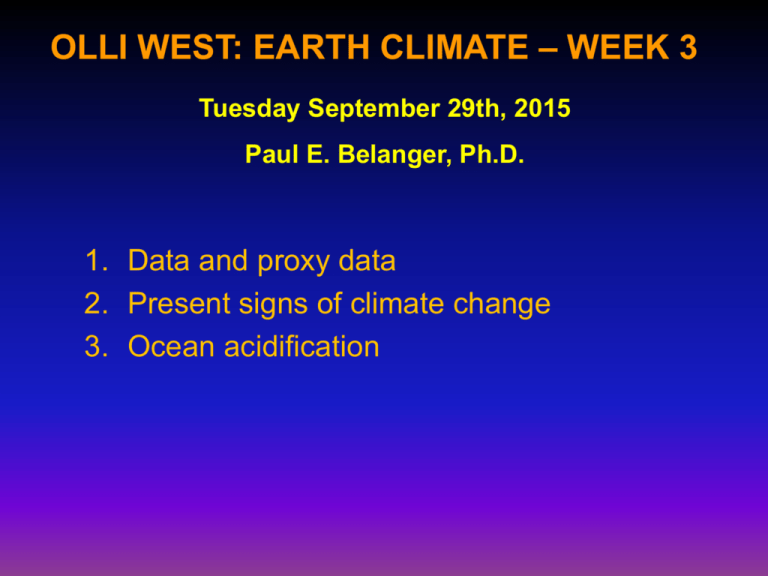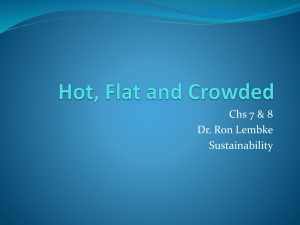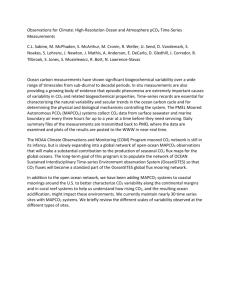Belanger wk3 proxies-present signs ocean acid
advertisement

OLLI WEST: EARTH CLIMATE – WEEK 3 Tuesday September 29th, 2015 Paul E. Belanger, Ph.D. 1. Data and proxy data 2. Present signs of climate change 3. Ocean acidification Data and proxy data • Data: Measurements – present and past • Thermometry • Ice bubbles, • Field measurements, etc. • Data Proxies: indirect measurements made from collected data to reconstruct past climates: geochemical proxies biological proxies lithologic proxies Data and proxy data Data has it’s errors Proxy data has even more errors Scientific History of Climate change – PROXY DATA SOME OF THE EARLIEST PROXY DATA WAS FROM TERRESTRIAL DEPOSITS • • • • • Strandlines/shorelines Moraines Till Kettle lakes, etc. Ice rafted debris/dropstones We may know what caused these today, but imagine back then? IT’S THE INTERPRETATION THAT’S NOT ALWAYS CORRECT Darwin observed ancient Alpine shorelines: interpreted as ocean shoreline Agassiz – later correctly interpreted as icedammed lake-shore strandlines/shoreline • Jean Louis R. Agassiz • “Father” of Glaciology • 1807-1873 • Paleontologist • Glaciologist Photographic proxy data/evidence Ruddiman, 2008 EARLY PROXY DATA: TREE RINGS Pollen & Lake core data Ruddiman, 2008 PROXY DATA: POLLEN DATA PROXY DATA: LEAVES Tree rings, corals, ice cores Ruddiman, 2008 PROXY DATA: ICE CORES TERRESTRIAL DATA North American: European: Wisconsin Wurm Illinoian Riss Kansan Mindel Nebraskan Gunz LATER EVIDENCE CAME FROM THE MARINE RECORD NOT WITHOUT IT’S PROBLEMS, BUT MORE COMPLETE Cesare Emilani: Paleontologist, Chemist Father of Paleoceanography Other Paleoceanographers Wally Broecker Thermal-haline “conveyor” belt of circulation Other Paleoceanographers Bill Ruddiman Nick Shackleton Other Paleoceanographers John Imbrie: CLIMAP PROXY DATA: CORE DATA PROXY DATA: BENTHIC FORAMS PROXY DATA: PLANKTONIC FORAMS Deep Sea Coring Ruddiman, 2008 Isotopic fractionation How Rain, snow and ice gets progressively lighter in the ratio of O18/O16 • Normal Oxygen has 6 protons and 6 neutrons referred to as O16. • The rarer stable isotope of oxygen has 2 extra neutrons and is referred to as O18 http://serc.carleton.edu/microbelife/research_methods/envir on_sampling/stableisotopes.html How Rain, snow and ice gets progressively lighter in the ratio of O18/O16 SMOW http://atoc.colorado.edu/~dcn/SWING/overview.php Scher and Martin, 2006 On opening of the Drake Passage Drake Passage Scher and Martin, Science, v.312 p428, April 2006 …throws a curve ball in interpreting the graph of data below …we continue to learn/refine Geochemical data to make proxy measurements of temperature or sea level fall/rise and/or ice volume What’s data vs. interpretation Azolla event: ~ 49 Ma What’s data vs. interpretation http://www.antarcticglaciers.org/climate-change/ Causes for the increase of CO2 during interglacials and vice versa Warming caused the release of CO2 But so did the increase of ocean circulation We know this because the CCD was shallower during glacials http://www.pmel.noaa.gov/co2/story/Ocean+ Carbon+Uptake How C13 varies; PDB is the standard to compare to – it’s a Belemnite CaCO3 fossil: Understanding this helps make better interpretations Earth’s past climate 1. Earth’s deep past before the Cambrian (600 MaBP): hot and cold 2. Earth’s past: Cambrian onward: mostly hot-house Earth; 100s parts per million (ppm) 3. Climate trend in the Cenozoic – the last 65 million years; proxy data from 3600ppm to <200 ppm. 4. More recent past: 180-280 part per million; how do we know – empirical data. Preview of ice core lab field trip 5. Today: 400 ppm and growing Azolla event: ~ 49 Ma 50 million years ago (50 MYA) Earth was ice-free. Atmospheric CO2 amount was of the order of 1000 ppm 50 MYA. Atmospheric CO2 imbalance due to plate tectonics ~ 10-4 ppm per year. So – what changed? Volcanism decreased; some slowing of spreading rates = less CO2 emitted by volcanoes Weathering/Precipitation increased: • India colliding into Asia/Himalayas • Continents to higher latitudes: mechanical aided weathering increases chemical weathering Long-term Carbon Cycle: rocks Two generalized reactions… Photosynthesis/Respiration CO2 + H20 ↔ CH2O + O2 Weathering/Precipitation CO2 + CaSiO3 ↔ CaCO3 + SiO2 Long-term carbon cycle: rocks Berner, 2001 J. Ormes, 2015 THE PETM HYPERTHERMAL EVENT Azolla event: ~ 49 Ma So what are these hyperthermals like the PETM? Paleocene-Eocene Thermal Maximum • Negative carbon isotopes • Indicative of methane release • Calcium compensation depth rises • = more clay rich sediments vs. carbonates • Ocean acidification • Onset rapid; <20,000 years • Recovery longer: ~100,000-200,000 years https://en.wikipedia.org/wiki/Paleocene%E2%80%93Eocene_Thermal_Maximum PETM - THE LAND RECORD Bighorn Basin PETM interval in fluvial deposits with excellent alluvial paleosols - seen as color bands, which are soil horizons Found in Willwood Fm Reds, purples due to iron oxides in B horizons Paleosol Density PETM Pre-PETM Bighorn Basin Climate Plant fossils and isotopes show Mean Annual Temperature of 20o to 25o C or 68 to 77o F Similar to Gulf Coast region today Locally the Dawson D2 formation may be because of the PETM Earth’s past climate 1. Earth’s deep past before the Cambrian (600 MaBP): hot and cold 2. Earth’s past: Cambrian onward: mostly hot-house Earth; 100s parts per million (ppm) 3. Climate trend in the Cenozoic – the last 65 million years; proxy data from 3600ppm to <200 ppm. 4. More recent past: 180-280 part per million; how do we know – empirical data. Preview of ice corelab field trip 5. Today: 400 ppm and growing Climate Changes from Ocean Sediment Cores, since 5 Ma. Milankovitch Cycles the last time inferred temperatures will have been this high – once equilibrium is reached, will have been 3-5 million years ago or more 5.0Ma 4.0Ma 41K 3.0Ma 2.0Ma 100 K 1.0Ma When CO2 levels get below ~400-600 ppm Orbital parameters become more important than CO2 * 0 we are now about here Earth’s past climate 1. Earth’s deep past before the Cambrian (600 MaBP): hot and cold 2. Earth’s past: Cambrian onward: mostly hot-house Earth; 100s parts per million (ppm) 3. Climate trend in the Cenozoic – the last 65 million years; proxy data from 3600ppm to <200 ppm. 4. More recent past: 180-280 part per million; how do we know – empirical data. Preview of ice corelab field trip 5. Today: 400 ppm and growing OLLI WEST: Signs of Climate change • We are changing the climate: – CO2 – CH4 – And resulting temperature increases Lest we forget: CO2 is still going up * 400 ppm http://en.wikipedia.org/wiki/Keeling_Curve What about Methane? http://www.esrl.noaa.gov/gmd/aggi/aggi.html http://clathrates.blogspot.com/2012/04/threat-of-methanerelease-from.html SOURCE OF METHANE How do we know we are causing it? – CO2: • Isotopically more negative Carbon (see next slide) • Reduction of C14 in atmosphere – dead carbon – And if you believe in the laws of Physics (see first handout and video on GHGs) then it’s the main reason along with positive feedbacks for Global warming (and ocean acidification) http://www.cmar.csiro.au/research/capegrim_graphs.html http://www.bridge.bris.ac.uk/projects/pcmip/ experiments.html The past 20 years pre-industrial value 6.4 The past 1000 years We see the effect in corals, too. “Evidence for ocean acidification in the Great Barrier Reef of Australia”, G. Wei et al. 2009, Geochimica et Cosmochimica Acta, 73, 8, 15 April 2009, Pages 2332–2346 90% of the energy is going to heat the oceans; the rest heats the land and air. 1022 Joules The ocean is taking up the heat A few % is melting ice. http://www.realclimate.org/index.php/archive s/2013/09/what-ocean-heating-reveals-aboutglobal-warming/ OTHER EVIDENCE Oxygen used by burning The observed downward trend is 19 ‘per meg’ per year. This corresponds to losing 19 O2 molecules out of every 1 million O2 molecules in the air/year. http://scrippso2.ucsd.edu http://takvera.blogspot.com/2014/01/antarctic-ice-mass-accelerating.html Energy consumption rises China biggest emitter 2007 emissions: Population matters! •14% more than US •Per capita Pop. U.S.: 19.4 0.31 Russia: 11.8 0.14 E. U.: 8.6 0.50 China: 5.1 1.33 India: 1.8 1.14 tons Billions Netherlands Environmental Assessment Agency 2008 Tons of CO2 per capita Human production of CO2 • Atmosphere as a waste dump • Solid waste produced annually about 1 billion metric tons • Fossil fuel burning -> 30 billion metric tons/year (30 x 109)/(300 x 106) = 100 • By mass in the USA (20x) – 250 M tons of trash to landfills (not including the recycled waste 87 M tons) – 5200 M tons of CO2 emitted from burning fossil fuels Coal and oil drove an amazing expansion of human possibilities Got to love ‘em: These fuels have supported an exploding population and a fantastic lifestyle for many (but not all). 20th Century growth rate was “super exponential” until inflection point circa 1980 Human species 0.5 billion: 1600 1 billion: 1802 202 years 2 billion: 1928 126 years 4 billion: 1974 46 years 8 billion: 2030 56 years 9 billion: 2050 20 years Ocean acidification o CaCO3 + H2CO3 = Ca+2 + 2HCO-3 [1] o H2CO3 is carbonic acid - a relatively weak naturally occuring acid that forms by the reaction between water and carbon dioxide: H2O + CO2 = H2CO3 [2] o http://www.pmel.noaa.gov/co2/story/Ocean+ Carbon+Uptake U.S. CO2 Emissions have come down http://www.texog.com/blog/2012/07/23/shaleboom-helps-us-achieve-largest-co2reductions-in-the-world/ http://www.c2es.org/facts-figures/usemissions/electric-power THE END WEEK 3 EXTRA BONUS: THE AZOLLA SEQUESTERING EVENT – Read more at: https://en.wikipedia.org/wiki/Azolla_event Summary: Acex coring expedition 2004 • Arctic ocean became fresh water on surface • Fresh, salinity intolerant fern, Azolla, grew and covered the Arctic ocean • Died off every winter and sunk to the anoxic bottom • 800,000 years of organic matter preserved • Sequestered 500-1000 ppm CO2? ARCTIC EVENTS Brinkhuis et al,, 2006 Moran et al., 2006 The Arctic Sea 50 million years ago ACEX Azolla core • >8 meter ACEX core with 90% Azolla • Azolla occurs as laminated layers • indicates Azolla deposited in situ • bottom-water anoxia at ACEX site Bujak, pers. Comm. UNPRECEDENTED DROP IN CO2 the massive decrease in atmospheric CO2? Bujak, pers. Comm. can this be used to predict the effect of future increases in CO2 ? climate models indicate that full Antarctic glaciation cannot occur unless CO2 ppm is less than 1000 ppm 600 ppm poor data 800 ppm 1200 ppm Bujak, pers. Comm. A Climate knowledge quiz: • http://www.csmonitor.com/Environment/2014/082 7/Climate-change-Is-your-opinion-informed-byscience-Take-our-quiz/Gas IS CLIMATE CHANGE ALL DOOM AND GLOOM? • Answer: NO! • • – but YES it’s a challenge and as humans we have always been challenged: • read the history books. • That doesn’t mean we stick our heads in the • sand and ignore the challenges. • We have human ingenuity and adaptability. • Is ignoring and doing nothing an appropriate answer. Is resigning oneself to abdicating addressing the issue merely a way of dismissing and saying there’s nothing we can do. There are a lot of smart people working to meet those challenges – let me cite 2 that might be “game changers“. More at: http://denverclimatestudygroup.com/







